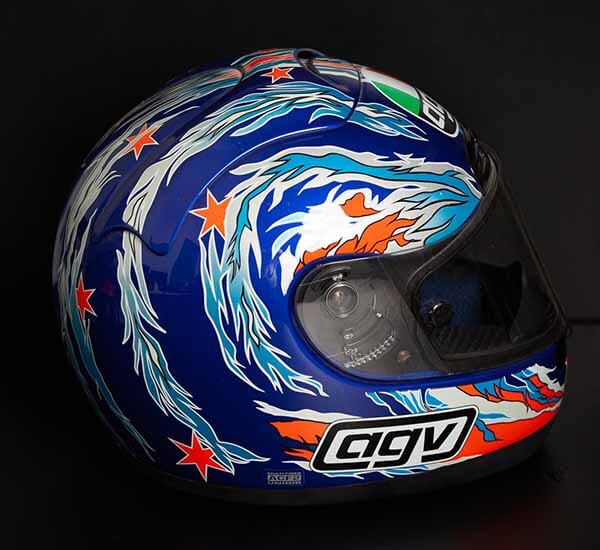Although there is a wide variety of motorcycle helmet styles to choose from, they generally fall into one of three broad categories: full-face motorcycle helmets, also known as full coverage or integral helmets; three-quarter helmets, also known as jet helmets; or half helmets.
Diehard fans in each of these groups will passionately argue that their choice of helmet is the safest, often supporting their claims with a list of reasons. However, stepping back and approaching the question from a purely logical and neutral standpoint, one might consider that full-face helmets cover the largest area.
Therefore, it could be assumed they are the safest choice, but is that true? Are full-face motorcycle helmets truly safer? Can full-coverage integral helmets effectively reduce the risk of head injury?
Helmet Model Category Price (RRP) Check & Shop Now
AGV K1 S Best Sport/Road $229.95 RevZilla | MotoSport | Amazon
KYPARA Best Cruiser/ATV $99.90 Amazon
Yema Best Street/Urban $69.99 Amazon
Torc Modular Best Cruiser/Touring $149.99 Amazon
ILM Z501 Best Dual Sport/Street $139.99 Amazon
Bell Qualifier Best Urban/Commuter $129.95 RevZilla | MotoSport | Amazon
Scorpion EXO-R420 Best Sport/Touring $164.95 RevZilla | CycleGear | Amazon
Icon Airform Most Versatile $159.00 RevZilla | MotoSport | CycleGear
Sedici Strada 3 Best Bluetooth-Enabled $279.99 RevZilla | CycleGear | J&P Cycles
Are Full-Face Motorcycle Helmets Safer?
Full-face motorcycle helmets are 45.3% safer than other available motorcycle helmets. They offer the most extensive coverage of the head, including the chin and jaw, providing complete facial protection.
Unfortunately, the world is seldom black and white, and this is one such instance where a range of variables influences the safety and performance of full-face motorcycle helmets.
Logic and neutrality are fine in theory, but the real world brings challenges of its own that create issues regarding safety for the full-face helmet. While it’s important to be aware of these challenges, they are less serious than the increased risk of a traumatic head injury associated with half and three-quarter helmets.
Reasons Full-Face Helmets Are Safer

When comparing the full-face helmet with the half or three-quarter helmet, the difference in coverage area is evident for all to see. This disparity also has practical implications, with the full-face helmet offering protection not only in the event of an accident but also while riding, shielding from debris and adverse weather conditions.
However, individuals who have experienced a bug in the eye at 80 mph would also consider bug protection essential.
In the 1980s, Dietmar Otte embarked on quantifying how much safer full-face helmets were compared to their competitors, analyzing recent motorcycle accidents to determine the primary impact location. The distribution of impact locations relevant to the helmet is illustrated below.
By determining the proportion of primary impacts occurring in locations not protected by other non-full-face helmets, Otte concluded that the full-face helmet was 45.3% safer.
In 2009, the study was replicated. The Motorcycle Accidents In-Depth Study results mirrored Otte’s findings, lending further credibility to the original research and providing concrete evidence that full-face helmets are safer than their half and three-quarter helmet counterparts.
The Benefits of a Chin Bar on a Full-Face Motorcycle Helmet

What makes these studies even more intriguing is the focus on the number of impacts occurring in the chin bar area, a feature notably absent in half and three-quarter helmets. Otte’s research revealed that the primary impact in most accidents occurred on the chin bar (34.6%). Similarly, an Australian study highlighted the significance of the chin bar, showing that the jaw absorbs 50% of severe impacts in motorcycle accidents.
In contrast, the facial area, safeguarded by a shield in a full-face helmet, accounted for just over 10% of the primary impacts in Otte’s study. Even when the face wasn’t the primary point of impact, it remained vulnerable to cuts and abrasions in the majority of accidents, as indicated by the subsequent study.
Traumatic Brain Injury, Full-Face Motorcycle Helmets Lead the Way
The statistics concerning traumatic brain injuries resulting from motorcycle accidents provide compelling evidence regarding the varying levels of protection offered by different helmet types. Half helmets have been shown to provide protection against traumatic injury in 38.6% of motorcycle crashes.
Three-quarter helmets offer protection in 55.5% of accidents. In contrast, the full-face helmet leads the pack once again, safeguarding against traumatic brain injury in 69% of cases. Therefore, full-coverage integral-style motorcycle helmets undeniably offer superior protection against serious head injuries.

Neck Protection Provided by Full-Face
Full-face helmet provides protection for the neck area during an accident, a feature lacking in both half and three-quarters helmets. The absence of built-in neck protection in these helmet types underscores the additional safety benefit offered by the full-face helmet.
The Comfort and Performance of Full-Face Motorcycle Helmets
Some riders may resist the idea of giving up the sense of freedom that comes with the wind blowing in their face, which is experienced when wearing a half or three-quarters helmet. On hot days, these helmet types offer the advantage of keeping the rider cooler.
It’s important to acknowledge the potential risk of overheating or heat stroke for riders wearing a full-face helmet, especially in warm weather conditions. Both conditions should not be underestimated. However, knowledge empowers riders to mitigate this risk effectively.
While the possibility of overheating or heat stroke exists, it is not substantial enough to outweigh the increased risk of head injury if the rider opts for a half or three-quarters helmet. Despite this concern, the full-face helmet still stands out as the safer option in terms of overall protection. The situation reverses with half and three-quarter helmets in colder weather conditions.
Remember the humorous characters Harry and Lloyd as a reminder of the importance of making informed choices regarding helmet safety.

Do Full-Face Motorcycle Helmets Have Hearing Deficits?
One of the disadvantages of the full-face helmet is that the rider’s hearing is impeded, making it harder for them to hear other traffic, road noise and to communicate with other riders and passengers. Hearing is one of the ways riders identify hazards and manage risk while riding.
The limitations that a full-face helmet places on hearing do when looking at this one aspect render the full-face helmet less safe than its half and three-quarter counterparts. Again, this can be compensated for, making it a disadvantage but certainly not a factor that would make the helmet unsafe.
Not Quite Safety, Other Advantages of Full-Face Motorcycle Helmets
Although not entirely falling into the safety realm, there are a couple of other benefits offered by the full-face helmet. For the famous and (infamous), the full-face helmet provides extra protection we mere mortals probably do not appreciate, that of anonymity.
Although for those who have more than a few miles on the clock, a full-face helmet may allow them to pass themselves off as a marginally younger model. Half and three-quarters helmets might struggle to compete on those pain points.
While all men might be created equal, all motorcycle helmets are unfortunately not. The full-face helmet offers the best protection against traumatic brain injury among the three main types of helmets on the market today.
It also protects the entire head, something the half and three-quarter helmet cannot compete with. While there are some disadvantages relating to the heat when wearing a full-face helmet, they can be mitigated and managed. The clear evidence regarding the effectiveness of a full-face helmet cannot be ignored.
We only have one brain and should take whatever steps necessary to protect it, which in this instance means opting for the full-face helmet. They have been proven to be safer than the alternatives.
Coming from a former doctor and motorcyclist who has seen the devastating consequences of motorcycle accidents, honestly, hand in heart, anything less than full-face motorcycle helmets is not with the risk. Full coverage or integral motorcycle helmets, more commonly known as full-face motorcycle helmets are clearly the safest helmets available.
In Summary, Full-Face Motorcycle Helmets are the Safest of All the Different Types of Helmets
The full-face helmet is clearly the safest choice of styles of motorcycle helmet. Full-face helmets provide the greatest coverage for your head, face, and neck. Full-face motorcycle helmets also protect the rider from the environment including rain, sleet, snow, or debris and bugs striking your face shield.

I've diligently categorized my motorcycle gear recommendations into all available categories, with the aim of providing you with a comprehensive analysis that showcases the absolute best options for all your needs. These items are the culmination of in-depth research, extensive testing, and personal use throughout my vast experience of 50+ years in the world of motorcycling. Besides being a passionate rider, I've held leadership positions and offered consultancy services to reputable companies in over 25 countries. To See Top Picks and the Best Prices & Places to Buy: Click Here! |
Information for this article was partially sourced and researched from the following authoritative government, educational, corporate, and non-profit organizations:
FM/E













